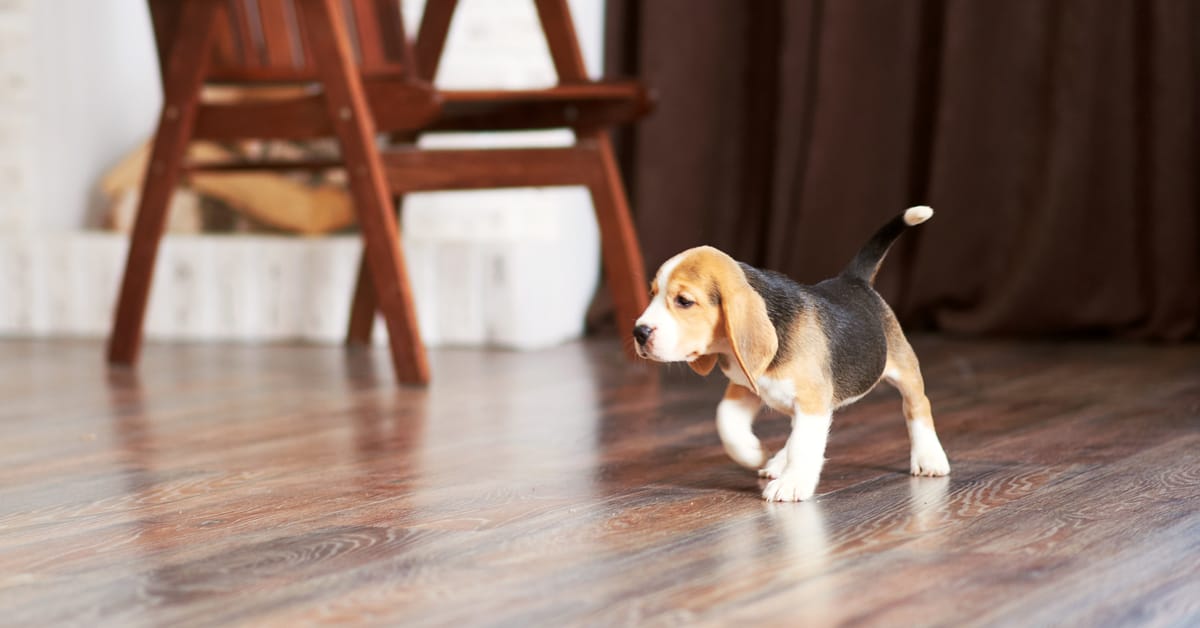Imagine this: you’re excited to show off your newly renovated living room, complete with gleaming hardwood floors. You call your furry friend, ready for a celebratory snuggle on the couch, but your dog hesitates at the doorway. Instead of bounding in, their tail tucks between their legs, their ears flatten back, and they refuse to take a single step onto the smooth surface. Why this sudden fear of a beautiful floor? It’s a common problem and often has surprising explanations.

Image: outwardhound.com
This fear of hardwood floors isn’t just a quirk for some dogs. It’s a real anxiety that can cause stress and discomfort. In this article, we’ll explore the reasons behind your dog’s apprehension, delve into several possible causes, and offer practical tips for helping your furry friend become more comfortable on this once-dreaded surface.
Understanding the Fear: Why Hardwood Floors Can Be Scary for Dogs
Hardwood floors present a distinct sensory experience for dogs. Their paws may feel:
- Lack of Friction: Hardwood floors offer less friction than carpeted surfaces, which can make a dog feel unsteady and insecure. This is especially true for senior dogs or those with joint issues.
- Loud Noise: Every footstep can create a loud noise, which many dogs find startling and stressful.
- Cold Temperature: Hardwood floors can feel cold, particularly in the winter months, which may make a dog apprehensive.
- Slipping Hazard: When there are spills or dust on the floor, the surface becomes even more slick. For a dog, slippery floors can be frightening and lead to painful falls.
Common Reasons for Hardwood Floor Anxiety
1. Past Negative Experiences: A traumatic experience on a hardwood floor, like a slip, fall, or painful nail trim, can leave a lasting impression. This association with the surface can lead to generalized anxiety and fear.
2. Sensory Sensitivity: Some dogs are simply more sensitive to sensory changes like floor texture and sound. Their heightened senses make them more likely to be startled by the unfamiliar sensations of hardwood floors.
3. Lack of Familiarity: Just like people, dogs thrive on familiarity. A sudden change in flooring can be stressful, especially for a dog who has always lived in a carpeted home.
4. Underlying Medical Conditions: Pain from arthritis, neurological issues, or other ailments can make movement and walking on harder surfaces painful and lead to fear and reluctance.
5. Age and Physical Limitations: As dogs age, they may experience reduced grip and flexibility. This can make navigating smooth surfaces more difficult, leading to anxiety and reluctance.
Calming the Fear: Helping Your Dog Adjust to Hardwood Floors
1. Start Slowly: Instead of immediately forcing your dog onto the hardwood, start small. Encourage them to explore the new surface with treats and praise. Let them sniff and investigate the floor at their own pace.
2. Positive Reinforcement: Reward every step onto the hardwood with verbal praise, pets, and their favorite treats. This positive association will help them overcome their fear.
3. Build Confidence: Use a well-loved toy as a lure, enticing your dog to walk across the hardwood. Make it fun and rewarding, keeping the sessions short and positive.
4. Create Traction: Consider using anti-slip floor mats or rugs in high-traffic areas. These can provide more traction and reduce the risk of slips and falls.
5. Introduce Gradual Sensory Exposure: Begin by placing a few objects on the hardwood floor, rewarding your dog for approaching and inspecting them. Gradually increase the amount of time spent on the floor, building a positive association.
6. Professional Consultation: If your dog’s fear is severe or persistent, consider seeking guidance from a veterinarian or certified dog trainer. They can help identify the underlying cause and create a customized desensitization plan.
7. Addressing Underlying Conditions: If you suspect any medical issues, schedule a veterinary appointment. Addressing any medical concerns can help improve your dog’s mobility and overall comfort.

Image: stoutrobert.blogspot.com
Expert Insights and Actionable Tips
A certified dog trainer, Emily Johnson, emphasizes the importance of patience and consistency. “Helping a dog overcome floor anxiety takes time and understanding. Be patient, understanding, and use positive reinforcement to build their confidence,” she says.
Dr. David Miller, a veterinarian, suggests, “Consider placing a non-slip rug in high traffic areas where your dog spends a lot of time. This will provide them with a secure footing and help them feel more comfortable moving around.”
Dog Scared To Walk On Hardwood Floors
Conclusion
Helping your dog overcome their fear of hardwood floors can be a journey. Remember, with patience, positive reinforcement, and a little understanding, you can help your furry friend feel secure and confident on any surface. Start by implementing the tips outlined above and consult with a professional if necessary. And remember, every step they take onto the hardwood, regardless of how small, is a victory!



/GettyImages-173599369-58ad68f83df78c345b829dfc.jpg?w=740&resize=740,414&ssl=1)


